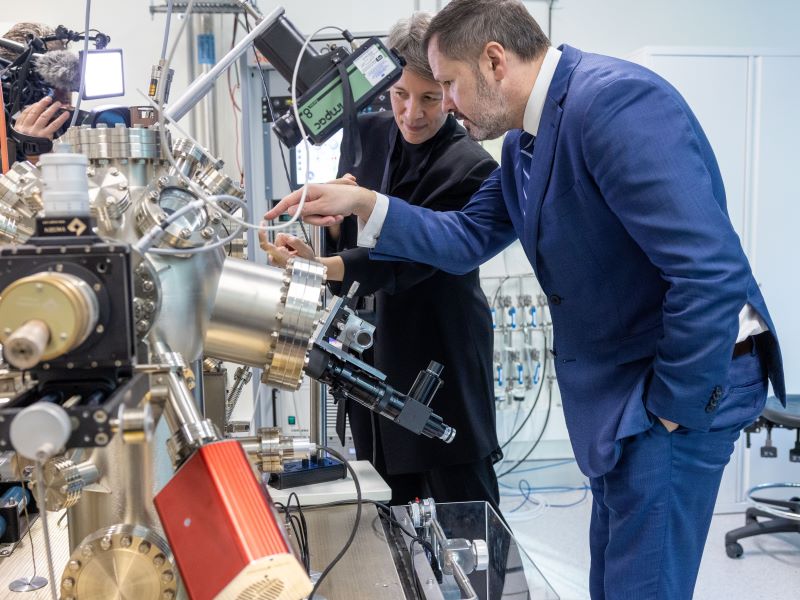Ed Husic was in the Senate chamber late on Tuesday night to witness his signature National Reconstruction Fund bill pass, marking a touchstone moment for Australian industrial policy.
The Industry and Science minister’s staff were all in the public gallery to share the moment, having been alerted to the imminent vote by senior policy staffer David Masters, who had been keeping an eye on amendments as they were dealt with from the advisor’s box.
Celebrations in the chamber were quiet, with Senators moving to Mr Husic to shake hands and offer congratulations.
But when the Prime Minister Anthony Albanese called a press conference in the Blue Room at the Parliament at 8.30am the following morning alongside his Industry minister – and ahead of the House of Representatives formalising the passage of the legislation – there was no mistaking this landmark.
Compared to global trading giants and alliance partners, the $15 billion National Reconstruction Fund is modest. But for Australia it is massive. It is a loud, optimistic and confident signal to local researchers and innovators.

And that is how it has been received. This is a “let’s go” moment for manufacturers generally, but for Deep Tech companies in particular.
The 2021 Bakerian Medallist and former Australian of the Year, physicist Michelle Simmons, says the NRF is “tailor-made” for Deep Tech companies like Sydney-based Silicon Quantum Computing, where she is chief executive officer.
“The NRF is tailor-made for deep tech companies like us, who represent the future of Australian industry and jobs,” Professor Simmons said.
“The support it will give to critical technologies such as quantum, will help us maintain the lead we’ve taken on these important areas.”
Sally-Ann Williams from Deep Tech incubator Cicada Innovations says the NRF will help plug some critical holes, especially for Deep Tech companies that are seeking to scale.
“These companies are the foundation of our future industries in areas of critical needs globally, including businesses working on climate, energy, health, food and more,” Ms Williams said.
The challenge for the NRF to achieve its ambitious goals will be in aligning broader state and federal policies – particularly in education – to establish clear pathways for businesses to start and to scale.
Port of Newcastle chair and innovation ecosystem expert Professor Roy Green told InnovationAus.com that the NRF was a key building block of a serious, purposeful industrial strategy, “the first we have been able to visualise for many years”.
Professor Green is keen to hear more details. He said the hollowing out of Australia’s manufacturing capability – which Mr Husic has acknowledged – had resulted in a productivity slowdown, wage stagnation and failure to prepare for a more knowledge intensive, net-zero emissions economy.
“While we are yet to hear more details of its investment mandate and how it will connect with our research and innovation system, we can be confident that the NRF will be transformative for many businesses in the seven identified priority areas.”
METS Ignited Industry Growth Centre chief Adrian Beer says the NRF could be a cornerstone for a new era of ambition and industrial growth in Australia – and to straddle the gap between research excellence and commercialisation success.
But it is going to need a long-term and ongoing commitment.
“When it comes to investing in science, innovation and research, the role of government is greater than funding grant programs or providing life support to market failures,” Mr Beer said.
“For Australian innovation to succeed globally, will require a long-term government commitment. Investments under the NRF will provide the patient capital that is needed to commercialise early-stage technology until the private sector is willing to take the risk,” he said.
Advanced Manufacturing Growth Centre (AMGC) chief executive Jens Goennemann says the passing of the NRF is significant for the nation’s manufacturing capability and puts industry policy “back on the map”.
But he says that the impact needs to be seen soon.
“The risk is that NRF cheque sizes are too big for most companies to absorb – or alternatively, cheque sizes are too small for the NRF to handle,” Mr Goennemann said.
“AMGC knows where the sweet spot is because this is where we have operated for the last seven years.”
Witnessing the passage of a bill can be a tedious affair, but for the big stuff, it can be exhilarating and totally worth it. And it has all been big stuff for Australia’s industrial policy this week.
Watching the National Reconstruction Fund being passed through the Senate on Tuesday night was an important moment.
On a personal note, I was in the Senate with my publisher Corrie McLeod and our friend Ella Hodgeman when the bill passed.
It was totally worth it, for no other reason than the fact that that night will be the underpinning for hundreds of stories in InnovationAus.com in the years to come.
Do you know more? Contact James Riley via Email.

